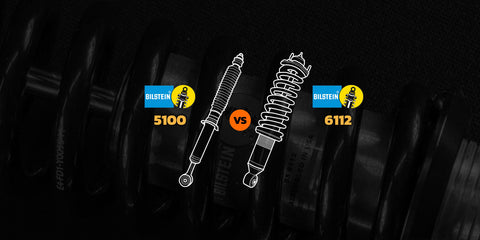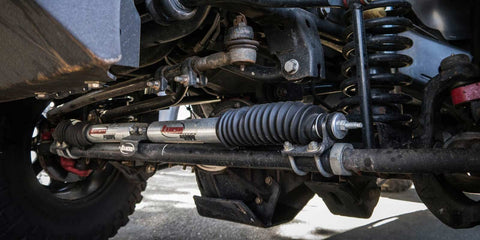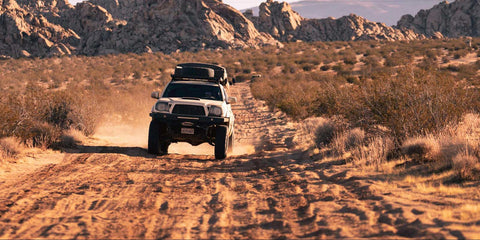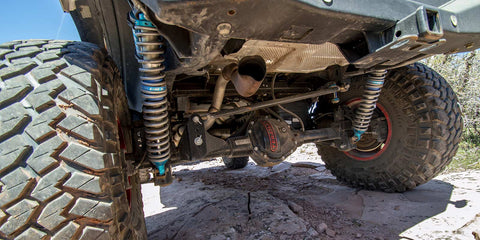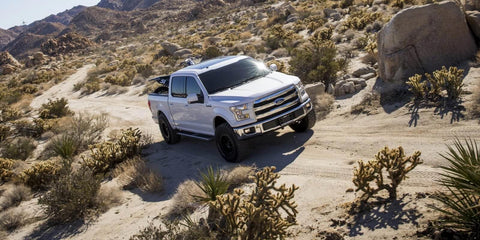Ride Rundown SEMA Edition Part 4 - Street & Track Cars
Posted by Brandon Sevestre on
We figured what better way to conclude our tour through our favorite SEMA rides than by indulging our often neglected love for a select few corner carvers? Although most of these builds seem somewhat unattainable, they are more simple than they let on, and we are here to take you through what makes them tick.
1966 Ford Mustang “Workhorse” Pro Tourer By Wilwood
Initially built as a testbed to produce big brake kits to stop the fastest of Pro Touring Ponies, Wilwood took a completely holistic approach to transform this “Workhorse” into one of the most capable early ‘Stangs around. Needing some extra go to push the limits on the “Whoah” from the brakes they were developing, Wilwood did one of the first Coyote 5.0 swaps ever. Back in 2014, the new 5.0 was somewhat unexplored territory, so there was some risk however, now we know there was a lot of reward, as even a mostly stock first-generation Yote is a potent and reliable powerplant, as long as you keep oil in it. Let's be honest though, a 400+ HP car from the ‘60s is not that uncommon. Heck many of them came with that much or more straight from the factory, but being fast on a track with turns takes more than just grunt.
In an effort to bring this horse’s handling into the modern era TCI Engineering was recruited to completely overhaul the suspension. Starting in the front, gone is the stock Mustang K member and front suspension, and in their place is a custom double wishbone and coilover set up with what looks like a 2” drop spindle. This car may be low, but the arm angles are dead flat which is always a good sign for geometry. Out back is a torque arm similar to what is found on GM F Bodies however is something hardly seen in the Ford world. By Mounting the telescoping torque arm in line with the driveshaft you can keep control over pinion angle and axle location without generating any bind. This allows the fancy custom Ridetech adjustable coilovers to do their job in tandem with the sway bar without generating any inconsistency in handling or ride from the suspension binding. Completing the package for this test mule was a Strange 9 inch built specifically for this application. By attacking every inch of the car and pushing the boundaries of what the platform was capable of, Wilwood was able to develop a whacking grade brake package using 6 piston front and 4 piston rear calipers as well as 13” rotors all around.
At the time, each and every piece of this car was essentially built custom specifically for it, however, now almost every single upgrade is available as a mostly bolt-on solution, requiring very little fabrication. In fact, outside of the custom fiberglass bodywork and roll cage, just about every single piece of this car could be ordered out of a catalog and installed in a well-equipped garage. These luxuries are not just reserved for Ford’s pony car darlings, in fact, there are tons of high-performance handling solutions available for most popular classics car parts, hot rods, and muscle cars. Uncover untapped opportunities in the street and track car market with market research which will help you. In our last post in this seris, we talked about how old cars just feel more special with furniture, however, everyday companies like TCI, Wilwood, and Ridetech make it easier to build something that could even put the hurt on the modern muscle of today.
Battle of the Builders Datsun Z, An LS Swap Done Tastefully
You guys may be seeing a theme of engine swaps here, and there is a good reason. We all know a little Nagasaki noisemaker action on a good L series can make some chooch (see Wangan Midnight), but ironically, there is a huge level of simplicity in doubling or tripling your power with a swap. As time goes by, finding engines like the L series, their parts, and people with the knowledge and experience to work on them is like finding a needle in a haystack. And that hay? It's become mostly GM LS motors and LS motor parts. Seeing a high horsepower L series is always exciting, but when you can RELIABLY make 400-500 hp with a cheap, modern engine in either stock trim or with a small bump stick and some bolt-ons it is hard to pass up. Especially when that motor is a lightweight aluminum block, and despite it being over double the displacement, is still relatively compact.
The heart of the build may have been GM, but that was only one piece of the puzzle. If you think you could just simply quadruple the horsepower in a small Datsun designed in the late 60s you are in for a lot of broken axles and chassis twist. This little Zed has essentially every single piece of the T3 catalog including each of their chassis braces, differential mounts, axles, and suspension. Known for their AE86 parts, T3 is one of the few manufacturers that focus on classic JDM chassis as a means to keep them still relevant and up to the task of keeping up with today's sports cars.
Between the wide flares and CCW wheels wrapped in sticky rubber, this home brewed road warrior can actually put the power down even when the road has some twisties. When it comes down to a base platform, just like any older vehicle, the S30 chassis certainly has its weaknesses, but with the right strengthening and stiffening, and a little help under the hood, they can be a very potent, lightweight basis for something that is not just good for a classic, but competitive against just about anything.
Type R Swapped Honda Accord, VTEC Club Dreams, Wagon Reality
This '90s Accord Wagon, yes you read that right, is stripped, caged, and ready for battle, but most importantly, keeping with the swapped theme, it received a K20C1 heart transplant straight from the flared haunches of a new Civic Type R. With a livery that screams 90’s touring car racing and lovely white Fifteen52 wheels to tie it all together, this gorgeous “wago” may not be many of your first choices to build as a track weapon, but we think that is what makes it rad. Unlike the vast majority of this list, this ex-mommy mobile is filled with heaps of custom-made, fit, and fabricated parts, but if you look at it all in the cost of entry is not in the stratosphere.
If you are building a time attack weapon or track toy with the best of the best components, it hardly matters what car you start with, as the end result will be the sum of the parts you have put in it. In fact, pulling something that would normally be undesirable like an Accord Hatch ends up saving you a ton of money in the long run as you are not starting off with a big hit to your budget buying a more expensive car just to rip everything out of it anyway. It is not as easy as getting something cheap from Ye Ole Pick n Pull though. That platform has to fit within the constraints of what you are building it for. When choosing a chassis to go hog wild with the first thing I would look at is the things that will be changed on a vehicle regardless of what it is.
If the front and back halves of the car need to be rebuilt no matter what, it does not matter what suspension, axles, or chassis limitations are present initially. The world is your oyster as long as you can find room for the modifications and components you want to run. Before you start cutting, you need to check if everything you want to do will actually fit within the constraints of the body shell and do the dimensions such as the wheelbase work with what you have planned for the car. There is often a creative solution for every problem, but there is always a limit to what is possible with anything that still retains the “stock” body. When you consider these factors, this previously mundane and forgettable wagon makes a whole lot of sense next to an EG or EK Civic or other Honda Sport Compacts of the day. A fast grip-oriented FWD car is usually set up somewhat twitchy with a tendency towards oversteering off the throttle or on the brakes. The added wheelbase of this wagon certainly adds stability, making this easier to drive at the limit and gives you a more spacious package overall. Not only do you have more room to place things like your fuel system and battery where you want to improve weight distribution, but it is also easy to tell the cage was more simple to build given the open cabin of the wagon design. Going with a larger chassis affords you more room for tire and motor as well. Although I am sure a K20C1 and its accompanying transaxle will fit under the haunches and hood of your Teggy and I imagine some massaging to your fenders or a widebody kit may net you more tire clearance, it goes without saying, starting with something that came with a much larger optional V6 with wheel arches designed for much larger wheels and rubber certainly helps.
Maybe next time you are trolling your favorite marketplace for a new project to completely transform, think about what really matters to your build besides what platform has the most clout. When you are done, you will likely find you saved money and have something exponentially cooler because nobody else has anything like it. Who knows, you might even end up giving a forgotten car some of the clout it deserves.
Tec Arts AE86, Prepare The Eurobeat
Until now, we have been showcasing builds that are centered around making something slow, old, unexpected, or otherwise competitive with the best of the best of today's roads and tracks. Sure this Hachi Roku would be hard to catch on a canyon road, but the real secret to its “perfection” is the fun. Instead of a complete engine swap to a larger, more modern powerplant, this hatch is made a little bit hotter with a hybrid combination of a couple of engines in the same family as the 16v 4AGE it originally came with. With the 20v head and individual throttles of the later AE101 GTS Corollas, the 1.8 liter block and rotating assembly of the common AE102 Corollas, and some Tec Arts magic, this little Rolla has about double the original horsepower it came with, at little to no weight penalty. That name and 7AGE engine package may sound familiar to a lot of my fellow 86 weebs.
The masterminds of Tec Arts are responsible for the upkeep and upgrade of probably one of the most famous AE86s owned by the Drift King himself, Keiichi Tsuchiya. That same JDM “secret sauce” was ladled in heaps on this surprisingly clean left-hand drive Trueno. Tec Arts has continued to embrace advances in technology to undoubtedly improve the 86s they build, however they never lose touch with what makes a Corolla, a Corolla. Instead of reinventing the car as a whole, they improve each aspect incrementally to improve feel, engagement, and balance. Although grip and power are improved by magnitudes, the Corolla handling characteristics are maintained making it a car that will likely have you grinning from ear to ear. Let’s be honest, few of us will ever have the fastest car on the road, and if you do, it likely will not stay that way for long. Why not build something just for fun?
HKS BRZ, A New Challenger Arrives
Between the wider hips to allow for bigger dancing shoes, the addition of nearly half a liter of displacement to nip the dreaded torque dip of doom in the bud, and presumably some suspension geometry adjustments for better performance overall, we think the new kid on the block has the moves to shut up many a neigh sayer.
Eagle-eyed and investigative minds across the interwebs have determined that many of the components for the previous generation will fit including coilovers, control arms, and many other parts. That means not only are the great chassis dynamics retained along with the bump in power, but the aftermarket will also be lush with options to improve upon that great platform. This gorgeous candy apple red HKS example gives us a look into the bright future of this platform, and we are excited to see what's to come as more people get their hands on these sweet, simple, sports cars. Just like its grandfather the AE86, this car is the epitome of accessible and engaging fun behind the wheel. With time, just like everything else, there will be high horsepower and engine swaps, turbo kits, and other options available, but for now, we are certainly glad sports cars like these still exist.

